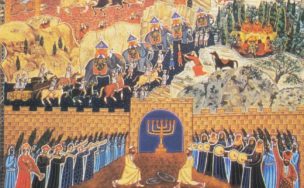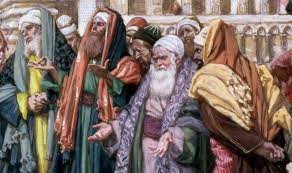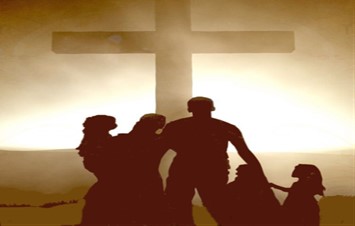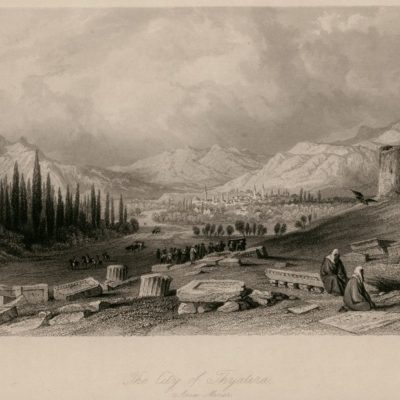Hasmonean Dynasty

The family Hasmonean also called Maccabees raised a revolt that proved successful severe struggle. Mattathias and his sons gathered a guerilla army fighting a war against the Syrians as well as attacking Jews who had abandoned the observance of practices in the Torah. Antiochus IV revoked the bans against Torah observance. Judas Maccabeus and his revolutionary army defeated the Syrians, recaptured the temple, and purged it of pagan symbols in 164 BC. Hasmonean Dynasty or Maccabean family believed they were divinely chosen to save Israel. The conquests of the Maccabean family are described in the first Book of the Maccabees and describe events in Jewish history from the time of Antiochus Epiphanes in 175 BC to the rise of John Hyrcanus, Son of Simon, last of the Maccabean brothers in 134BC. The First Book of the Maccabees contain the persecution and the revolt of Mattathias, the leadership of Judas Maccabeus and the leadership of Jonathan it ends with the leadership of Simon of Simon Maccabeus.
The Hasmonean dynasty was established under the leadership of Simon Maccabaeus, two decades after his brother Judas the Maccabee (“Hammer”) defeated the Seleucid army during the Maccabean Revolt. According to 1 Maccabees and 2 Maccabees after Antiochus IV’s , who was the descendant of a general of Alexander the Great, had firmly established himself as king of Syria, he decided to conquer Egypt and rule that country as well as Syria. Antiochus was able to capture the fortified cities of Egypt and plunder the whole land. Antiochus marched with a great army against the land of Israel and the city of Jerusalem in the year 143, after the conquest of Egypt. He entered the temple and took away the gold altar, lamp stand with all its equipment, the table for the bread offered to the LORD, the cups and bowls, the gold fire pans, the curtain, and the crowns. He also stripped all the gold from the front of the Temple and carried off the silver and gold and anything of value, including all the treasures that he could find. Then he took it all to his own country. Antiochus also murdered many people and bragged arrogantly about it. There was great mourning everywhere in the land of Israel. (Maccabees 1:16-25. P 151).
Antiochus issued a decree that all nations in his empire should abandon their own customs and become one people. Many of the Israelites submitted to this decree and adopted the official pagan religion, offering sacrifices to idols, and no longer observed the Sabbath. Antiochus also appointed officials to supervise the people and commanded each town in Judea to offer pagan sacrifices. Many of the Jews were ready to forsake the Law and obey these officials. They defiled the land with their evil and their conduct forced all true Israelites to hide wherever they could. (Maccabees 1:41-53. p 152).
King Antiochus set up “The Awful Horror” on the altar of the Temple, and pagan altars were built in the towns throughout Judea on the fifteenth day of the month of Kislev in the year 145. Pagan sacrifices were offered in front of houses and in the streets. Books of the Law were burned. Anyone found with any Books of the Law or sacred books were put to death. (Maccabees 1:54-59. p 152).
Mothers who had allowed their babies to be circumcised were put to death in accordance with the king’s decree. Their babies were hung around their necks, and their families and those who had circumcised them were put to death. There were many people in Israel firmly resisted the decree and refused to eat food that was ritually unclean. They preferred to die rather than break the Holy Covenant and eat unclean food. (Maccabees 1:60-64. p 153).
Mattathias, a priest and grandson of Simeon, moved to Modein from Jerusalem and was appalled with the wickedness of King Antiochus. Mattathias and his followers went through the town shouting that everyone who was faithful to the covenant of God and obeyed His Law should follow him. Then Mattathias and his sons fled to the mountains. (Maccabees 2:1-28. p 154). Many of the Israelites who were seeking to be right with God through obedience to the Law went out to live in the wilderness taking their children, wives and livestock with them. A large force of soldiers from the king pursued them. When they caught up with them they set up camp opposite of them and prepared to attack them on the Sabbath. The Jews did nothing to resist the attack they were all ready to die with a clear conscience. The soldiers of King Antiochus killed the men, wives, children and livestock on the Sabbath. They killed a thousand of people. (Maccabees 2:29-39. p 154). This led Mattathias and his friends were saddened by the news. Mattathias and his friends were joined up by a group of devout and patriotic Jews, the strongest and bravest men in Israel, who had all volunteered to defend the Law. Everyone who was fleeing from the persecution joined them and strengthened their forces. Mattathias and his friends went everywhere tearing down pagan altars and circumcising by force every uncircumcised boy they found within the borders of Israel. They rescued the Law of Moses from the Gentiles and their kings and broke the power of the wicked King Antiochus. (Maccabees 2:239-48. ps 154- 155).
Judas Maccabeus took the place of his father Mattathias at his death to carry on the rebellion. When Judas was faced with an army of 5,000 trained troops to his 3,000 untrained troops Judas prayed to the Lord to have mercy on them. Judas told God that he would bring Him honor to His covenant. They were successful and victorious time and time again. Once they had defeated their enemies they went to Jerusalem to purify the Temple and rededicate it. The twenty-fifth day of the ninth month of Kislev, in the year 148 was the anniversary of the day the Gentiles had desecrated the altar of the Temple. They offered a sacrifice on a new altar in the Temple and dedicated it to the Lord for giving them the victory. The celebration went on for eight days. (Maccabees 3- 4. ps 155- 160).
The family name of the Maccabean priestly and kingly family who ruled over Israel from the 160B.C. until the Romans captured Jerusalem in 63 B.C. It was under the Hasmonean dynasty the kingdom of Judah extended its borders similar to the borders that King David established during his reign. Toward the end of the Hasmonean dynasty it became victim to the opposing factions that had emerged in the region under its rule and the power of the new Roman Empire. The Roman Empire brought “peace” to a region that the Hellenistic rulers had been unable to maintain. (Patzia. 2002. Pg 54-55).
Jonathan succeeded Judas after his death. The lawless traitors began to reappear in Judea and the wicked men returned. Jonathan had many successful campaigns and was made high priest On the Feast of Tabernacles in 153. Jonathan made alliances with Rome and Sparta. (Maccabees 8: 23-12. ps 169- 180).
Simon was the next leader of the Jews. Simon also had the support of the Jews and was successful on the battle field. Simon was a great and righteous person, loved by the people. He set for himself the task of rebuilding the Jewish State, reinvigorating the Jewish people, throwing the Greeks and Greek ideas out of the country and destroying all of the idols. Simon was the High Priest and had appointed Ptolemy, his son in law, as commander for the Plain of Jericho. Ptolemy became ambitious and wanted to take over the country. He devised a plan to assassinate Simon and his sons in 134BC. (Maccabees 8-16. ps 180- 187).
Simon oldest son, John Hyrcanus, was a fierce warrior, immediately rushed to Jerusalem and installed himself in his fathers place as both the High Priest and King. Then he rallied the Sanhedrin and the people to his side, rescued his mother who had been held for ransom and forced his murderous brother-in-law to flee. He helped strengthen the Torah education system in the land, was personally scrupulous in his observance of Jewish law and raised the bar regarding the service in the Temple improved the Temple edifice at great expense. He threw out the Greeks and kept the Romans trapped in around Caesarea. He took over vast areas of what is today Jordan and repopulated the Golan with Jews. He pushed the border of Israel to the outskirts of Damascus. He also took the seaport of Jaffe and Jews became partners with the Phoenicians in shipping and trade. That is when Jews began to move to North Africa to establish trade routes. Jews also reached Italy and Rome. Under his reign a large immigration of Jews emigrated from Babylon. He brought the country prosperity and greatness. He reigned until his death in 104 BC, when he was succeeded by his son Aristobulus I. (Rusten. 2005. P 63)
The Hasmonean dynasty ended in civil strife in 67 BC. A war broke out between two brothers, Hyracanus II and Aristobulus II, each fighting for the title of high priest and king. They appealed to Rome to settle the issue Pharisees and Essenes and the aristocratic supporters the Sadducees. They invited the Roman general Pompey to conquer Jerusalem in 63 BC to bring Judea under the Roman administration. (Johns. 2011. Ps 467-468).
General Pompey seized control of Jerusalem and the surrounding area assigning governors of Syria, and Judea and Galilee. He also confirmed Herod the Great as ruler in 37 BC and called him king. Judaism was tolerated in the early years of captivity. There were intermittent resistances from some of the Jewish population. When this happened the Roman turned to Herod to keep the peace and keep Roman satisfied.
The Old Testament period ended with the Assyrian and Babylonian exiles and the captives return from exile. The chief leaders became the scribes and Pharisees, who developed from the Hasidim, and the Sadducees who developed from the Hasmoneans or aristocrats of that period.
The New Testament period finds the political head under the Romans was the Herodian family. Herod the Great was an Idumean Arab and was made procurator by the Romans. Herod brought peace to the land and began rebuilding the Jerusalem temple in 46 BC, but he also built Roman temples and entire Roman cities in Palestine. When King Herod died in 4 BC his kingdom was divided between three surviving sons: Archelaus the governor of the province of Judea, Samaria, and Idumea. The son of Herod I the Great, Antipas, who became tetrarch of Galilee and Perea, he ruled throughout Jesus of Nazareth’s ministry. Philip was the tetrarch of Iturea, Trachonitis. Archelaus was a brutal ruler who was deposed and replaced by captains like Pilate. Antipas being a better ruler and is known for the execution of John the Baptist and for taking part in the trial of Jesus (Luke 23:7-12). Herod Agrippa II, a grandson, took part in Paul’s trial before Festus in Acts 25-26.
The high priest of this time had become the religious and civic leader of the Jews. He controlled the Sanhedrin in Jerusalem, a council of seventy-one members that was both the congress and the supreme court of the people. The major groups were the Sadducees, among whom were the “chief priests” or priestly aristocracy, the scribes who were trained experts in the interpretation of the Torah, many of whom were Pharisees, and elders who were the lay nobility. They decided religious, civic, and political issues that concerned the Jewish people according to the Romans who gave them and allowed them that authority. Legally, they had little authority in Galilee, a separate administrative region, but within Judaism they had influence even over people far from their ancestral home land. (Acts 9:1-2). They authorized Paul to take the persecution of Christians into Syria. (Johns. 2011. P. 470).
The synagogues had great influence at the local level. The “ruler of the synagogue” was the head official, though he tended to be a person given an honorary position. It was governed by three “elders”or lay leaders from the congregation. The synagogue was not only the center of instruction but was the core of the civic life of the community and the judicial center where discipline was ministered in civil affairs. Offenders were disciplined by flogging (Acts 5:40) and by excommunication (John 9:34).
References:
Deuterocanonicals/Aoicrypha. (1979).The First Book of Maccabees. Good News Bible.
New York; American Bible Society.
Johns, James L. (2011). “The History of Palestine Between the Old and New Testaments” In , in The Baker Illustrated Bible Handbook, ed. J. Daniel. Hays and J. Scott Duvall. Grand Rapids, MI: Baker Books.
Patzia, Arthur G. and Petrotta, Anthony J. (2002). Pocket Dictionary of Biblical Studies. Downers Grove, IL: InterVarsity Press.
Rusten E. Michael and Sharon. (2005). The Complete Book of When & Where in the Bible and Throughout History. Wheaton, IL: Tyndale House Publishers, Inc.
Cite Article Source
MLA Style Citation:
Holstein, Joanne “Hasmonean Dynasty:.” Becker Bible Studies Library Oct 2014.< https://guidedbiblestudies.com/?p=1470 ,>.
APA Style Citation:
Holstein, Joanne (2014, October) “Hasmonean Dynasty:.” Becker Bible Studies Library. Retrieved from https://guidedbiblestudies.com/?p=1470,.
Chicago Style Citation:
Holstein, Joanne (2014) “Hasmonean Dynasty:.” Becker Bible Studies Library (October), https://guidedbiblestudies.com/?p=1470 , (accessed).


